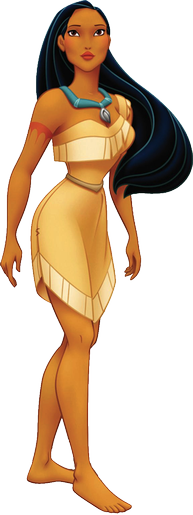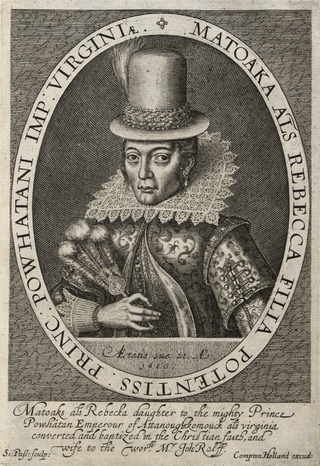
Pocahontas was a Native American woman belonging to the Powhatan people, notable for her association with the colonial settlement at Jamestown, Virginia. She was the daughter of Powhatan, the paramount chief of a network of tributary tribes in the Tsenacommacah, encompassing the Tidewater region of what is today the U.S. state of Virginia.

Pocahontas is a 1995 American animated musical historical drama film based on the life of Powhatan woman Pocahontas and the arrival of English colonial settlers from the Virginia Company. The film romanticizes Pocahontas's encounter with John Smith and her legendary saving of his life. It was produced by Walt Disney Feature Animation and released by Walt Disney Pictures.

Opechancanough was paramount chief of the Powhatan Confederacy in present-day Virginia from 1618 until his death. He had been a leader in the confederacy formed by his older brother Powhatan, from whom he inherited the paramountcy.

Tangled is a 2010 American animated musical adventure fantasy comedy film produced by Walt Disney Animation Studios and released by Walt Disney Pictures. Loosely based on the German fairy tale "Rapunzel" in the collection of folktales published by the Brothers Grimm, the film was directed by Nathan Greno and Byron Howard, and produced by Roy Conli, from a screenplay written by Dan Fogelman. Featuring the voices of Mandy Moore, Zachary Levi, and Donna Murphy, Tangled tells the story of Rapunzel, a lost young princess with magical long blonde hair who yearns to leave her secluded tower. She accepts the aid of an intruder, the outlaw Flynn Rider, to take her out into the world which she has never seen.

Glen Keane is an American animator, director, author and illustrator. As a character animator at Walt Disney Animation Studios for 38 years (1974–2012), he worked on feature films including The Little Mermaid, Beauty and the Beast, Aladdin, Pocahontas, Tarzan and Tangled. He received the 1992 Annie Award for character animation and the 2007 Winsor McCay Award for lifetime contribution to the field of animation. He was named a Disney Legend in 2013, a year after retiring from the studio.

Tarzan is a 1999 American animated coming-of-age adventure comedy-drama film produced by Walt Disney Feature Animation and released by Walt Disney Pictures. It is based on the 1912 story Tarzan of the Apes by Edgar Rice Burroughs, being the first animated major motion picture version of the story. The film was directed by Kevin Lima and Chris Buck and produced by Bonnie Arnold, from a screenplay by Tab Murphy and the writing team of Bob Tzudiker and Noni White. It stars the voices of Tony Goldwyn, Minnie Driver, Glenn Close, Rosie O'Donnell, Brian Blessed, Lance Henriksen, Wayne Knight, and Nigel Hawthorne.

Sleeping Beauty is a 1959 American animated musical fantasy film produced by Walt Disney Productions and released by Buena Vista Distribution. Based on Charles Perrault's 1697 fairy tale, the production was supervised by Clyde Geronimi, and was directed by Wolfgang Reitherman, Eric Larson, and Les Clark. Featuring the voices of Mary Costa, Bill Shirley, Eleanor Audley, Verna Felton, Barbara Luddy, Barbara Jo Allen, Taylor Holmes, and Bill Thompson, the film follows Princess Aurora, who was cursed by the evil fairy Maleficent to die from a prick from the spindle of a spinning wheel. She is saved by three good fairies, who alter Aurora's curse so that she falls into a deep sleep and will be awakened by true love's kiss.

Irene Bedard is an American actress, who has played mostly lead Native American roles in a variety of films. She is perhaps best known for the role of Suzy Song in the 1998 film Smoke Signals, an adaptation of a Sherman Alexie collection of short stories, as well as for providing the speaking voice for the titular character in the 1995 animated film Pocahontas. Bedard reprised her role as Pocahontas in the film's direct-to-video follow-up, Pocahontas II: Journey to a New World (1998) and for a cameo in Ralph Breaks the Internet (2018).

Pocahontas II: Journey to a New World is a 1998 American direct-to-video animated musical adventure film and the sequel to the 1995 Disney film Pocahontas. While the first film dealt with her meeting with John Smith and the arrival of the British settlers in Jamestown, the sequel focuses on Pocahontas's journey to England with John Rolfe to negotiate for peace between the two nations, although her death is omitted from the film's ending.
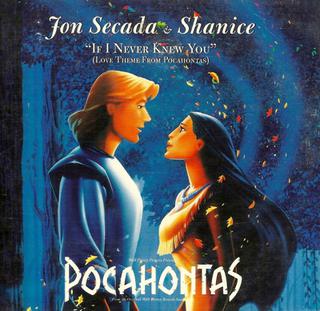
"If I Never Knew You" is a song by American singers Jon Secada and Shanice, from Disney's 1995 animated feature film, Pocahontas. The song was written by composer Alan Menken and lyricist Stephen Schwartz, and originally recorded by American singer Judy Kuhn in her film role as the singing voice of Pocahontas, and American actor Mel Gibson in his role as Captain John Smith. Shanice and Secada's version is heard during film's end credits, and was released on September 12, 1995, as the second single from the film's soundtrack by Walt Disney Records, after Vanessa Williams' pop and R&B rendition of the Academy Award-winning "Colors of the Wind".
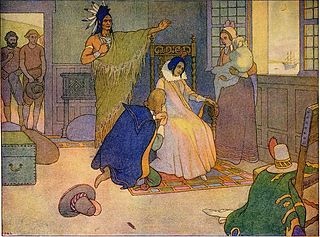
Uttamatomakkin was a Powhatan holy man who accompanied Pocahontas when she was taken to London in 1616.
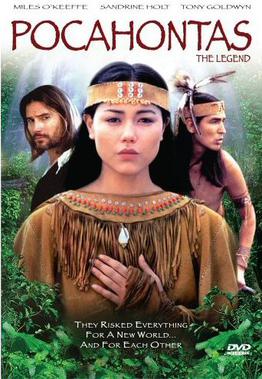
Pocahontas: The Legend is a 1995 Canadian drama film that fictionalizes the young life of the historical figure of Chief Powhatan's daughter Pocahontas and her relationship with Captain John Smith. This film, preceding Disney's animation version, was directed by Danièle J. Suissa and stars Sandrine Holt as the titular heroine. It was entirely shot around Toronto and Six Nations of the Grand River in Ontario, Canada.

Nik Ranieri is a character animator who is primarily known for his work at Walt Disney Animation Studios. He has been supervising animator of many characters and remained so until his layoff in 2013.
Mark Alan Henn is an American animator and film director. His work includes animated characters for Walt Disney Animation Studios films, most notably leading or titular characters and heroines. He served as the lead animator for Ariel in The Little Mermaid, Belle in Beauty and the Beast, Jasmine in Aladdin, Young Simba in The Lion King, the title character in Mulan and Tiana in The Princess and the Frog. He directed the short film John Henry. Henn spent a total of 43 years at Walt Disney Animation Studios, from 1980 until his retirement in 2023.

Rapunzel is a fictional character in Disney's animated film Tangled (2010). Based on the title character from the Brothers Grimm fairy tale of the same name, Rapunzel is a young princess kept unaware of her royal lineage by Mother Gothel, a vain woman who kidnaps her as a baby to hoard her hair's healing powers and remain young forever. Raised in a secluded tower, Rapunzel escapes with a wanted thief who promises to help her see the elusive floating lights in time for her 18th birthday, in exchange for a crown she has hidden from him. She is voiced by actress and singer Mandy Moore.
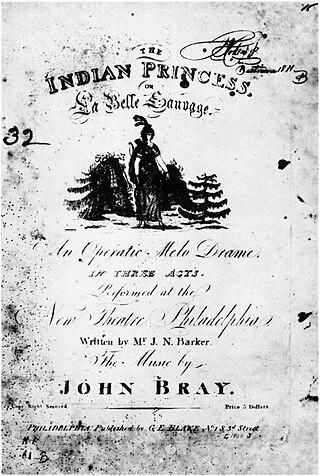
The Indian Princess; or, La Belle Sauvage, is a musical play with a libretto by James Nelson Barker and music by John Bray, based on the Pocahontas story as originally recorded in John Smith's The Generall Historie of Virginia (1621). The piece is structured in the style of a Ballad-opera, with songs and choruses, and also has music underlying dialogue, like a melodrama. Pocahontas persuades her father, King Powhatan, to free Smith and becomes attracted to John Rolfe, breaking off her arranged marriage with a neighboring tribal prince, an action that leads to war. Her tribe wins the war, but her father loses trust in the white settlers; Pocahontas warns the settlers who reconcile with Powhatan. Several comic romances end happily, and Smith predicts a great future for the new country.

Priscillano "Pres" Antonio Romanillos was an American animator with DreamWorks and Walt Disney. His work included animated characters such as the Native American Little Creek in DreamWorks' Spirit: Stallion of the Cimarron, Pocahontas, and the villainous Hun Shan-Yu in Disney's Mulan.
Pocahontas is a Disney media franchise that commenced in 1995 with the theatrical release of Pocahontas. The franchise is based on the real-life early 17th-century indigenous woman, Pocahontas.
The Indian princess is usually a stereotypical and inaccurate representation of a Native American or other Indigenous woman of the Americas. The term "princess" was often mistakenly applied to the daughters of tribal chiefs or other community leaders by early American colonists who mistakenly believed that Indigenous people shared the European system of royalty. This inaccurate portrayal has continued in popular animation, with characters that conform to European standards of beauty, with the most famous misrepresentation being that of Pocahontas. Frequently, the "Indian Princess" stereotype is paired with the "Pocahontas theme" in which the princess "offers herself to a captive Christian knight, a prisoner of her father, and after rescuing him, she is converted to Christianity and lives with him in his native land." - a false narrative which misrepresents the events of Matoaka's life. The phrase "Indian princess", when used in this way, is often considered to be a derogatory term, a type of racial slur, and is deemed offensive by Native Americans.

Pocahontas is a 1910 American silent short drama produced by the Thanhouser Company. The scenario was written by Lloyd Lonergan based on Lydia Sigourney's 1841 Pocahontas poem. The film is a retelling of the well-known story of Pocahontas, played by Anna Rosemond who saves the life of Captain John Smith, played by George Barnes. She is captured and held hostage by the English, converts to Christianity and marries Rolfe, played by Frank H. Crane. Pocahontas then sickens and dies, spending her last hours wishing to return to her native home. Released on October 11, 1910, the film was met with praise by most reviewers. It is believed that a replica of Hendrik Hudson's ship, Halve Maen, was used for the opening scene to establish the Jamestown landing. Though minor costuming and historical accuracy errors were pointed out, the film was praised as being of the highest quality of any Independent company. The film is presumed lost.
